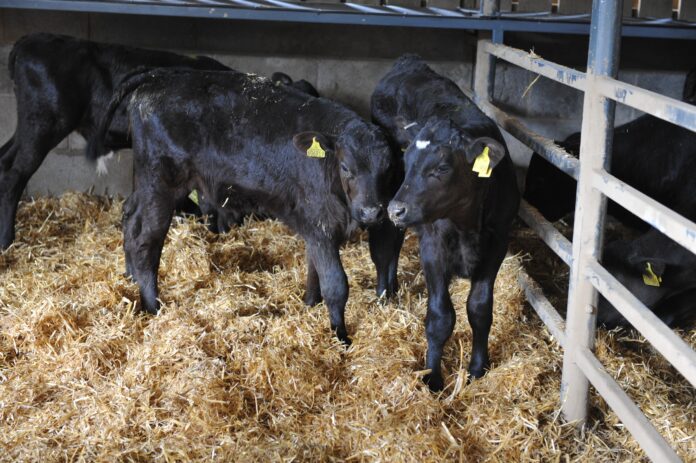Adjusting housing and feed intakes around weaning has helped a Welsh calf-rearer significantly reduce incidence of pneumonia.
Hugh Jones and his mother, Glenys, who farm at Pentre Farm, Pentrecelyn, source Aberdeen Angus bull calves from Buitelaar at an average of 36 days, when they weigh 65-85kg.
Pneumonia had been a major issue, affecting around half of all calves; this impacted on growth and, as a consequence, profitability.
Through their work as a Farming Connect Demonstration Site, the Joneses have been working with bovine veterinary specialist Owen Atkinson, of Dairy Veterinary Consultancy, to resolve this issue.
By introducing changes that focus on warmth, feeding and rumen development, there has been a major improvement, with pneumonia cases down to around 10%.
With guidance from Mr Atkinson and housing expert Jamie Robertson, changes have been made to the pre-weaning rearing shed at Pentre, to keep the environment as dry and warm as possible.

A double layer of Yorkshire boarding has replaced solid walls on two sides of the open-fronted shed, to give calves maximum protection from draughts – a measure that cost around £400; this will be used to replace the third wall, too.
Self-filling drinkers costing £850 have been re-sited and have replaced water troughs, to prevent moisture spilling onto straw bedding.
A 0.75m-wide shelf made of 40mm box iron and recycled plastic ‘stockblock’ sheets has been erected against the entire length of the back of the shed for calves to nestle under to avoid any cold downdraught.
A 150mm channel has been created at the front of the shed, too, to allow moisture to drain into it from the 5° gradient in the concrete floor.
More frequent bedding-up with straw at the front of the shed is a further measure to keep the pens clean and dry.
During a recent Farming Connect open day at Pentre Farm, Mr Atkinson said the open frontage of the shed provides ventilation – roof ventilation to capitalise on the stack effect is not applicable to young calves.
“Calves don’t generate enough heat until they are five or six months old for the stack effect to work,” he said.
It needs to be warmer on the inside of housing than the outside to trigger the stack effect; with larger animals, this would be driven by warmer air from their body heat exiting an outlet in the roof, creating a negative pressure which draws fresh air in from outside, similar to a chimney.
Alternatives are a shed with an open frontage to allow normal wind and air currents to drive in fresh air, or installing a ventilation tube. Smoke bombs can be used to identify draughts and air flow.
“A rule of thumb is that the smoke from a standard smoke pellet should be cleared from a shed within about one minute,” said Mr Atkinson.
A LoRaWAN sensor is used night and day to monitor temperature, humidity and light to gauge if calf coats are needed to reduce cold stress.
The feeding strategy around weaning has changed at Pentre Farm.
Mr Atkinson said a step-weaning policy, which reduces milk powder intakes three weeks before weaning, encourages calves to eat more concentrates, reducing the risk of ‘hay belly’ post-weaning.
Calves now receive 375g of milk powder, diluted to three litres, once a day at that three-week point, instead of that amount twice a day, and continue to be offered ad-lib concentrates and fresh water.
Calves are weaned at around nine weeks old, at which point they are comfortably eating 2kg of concentrates per head per day.
Mr Jones says the changes had made a big difference to calf health, with zero mortalities since they were put in place.
“It really has made calf-rearing enjoyable again,” he said.
This winter, he plans to make more changes to the shed, by insulating the roof.
Farming Connect is delivered by Menter a Busnes and Lantra Wales and funded by the Welsh Government and the European Agricultural Fund for Rural Development.
Help keep news FREE for our readers
Supporting your local community newspaper/online news outlet is crucial now more than ever. If you believe in independent journalism, then consider making a valuable contribution by making a one-time or monthly donation. We operate in rural areas where providing unbiased news can be challenging. Read More About Supporting The West Wales Chronicle






















